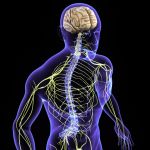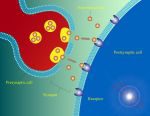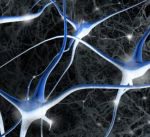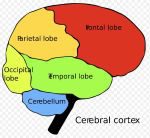Perhaps in the past, you have heard various descriptive terms for the nervous system such as Central, Peripheral, Somatic, Autonomic, Sympathetic and Parasympathetic. You may be thinking, “What does it all mean? What are the parts of the Nervous System and how are they different? How are they the same?” If you are trying to understand these differences, then this article is for you.
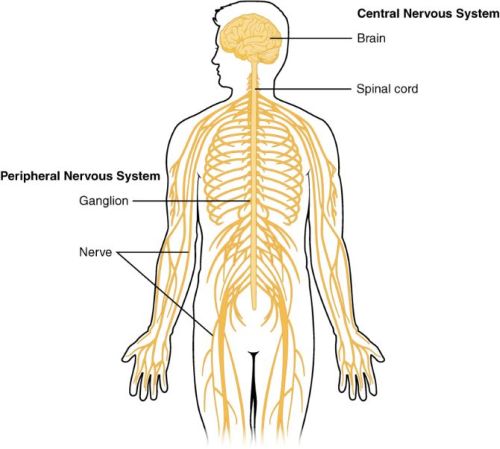
As you can imagine, there are entire college courses on this subject and it can get very in depth. That is not the purpose of this article, of course! This article is just to give you a basic knowledge of the differences between the main types or “parts” of the nervous system.
Because the consciousness (as well as the subconsciousness) of the mind transmits and receives information, an understanding of how that transmission and reception occur can sometimes be helpful. This is especially true whenever we have problems or issues that we want to correct. So, let’s try to break this down.
Here is a great video about Nervous System Basics:
The Two Main Parts of the Nervous System:
The Central Nervous System:
The two main parts of the nervous system are called the Central Nervous System and the Peripheral Nervous System. Such a simple sentence for such a complex subject!! The brain is (of course) beyond complex and there is still much about the brain that we do not understand. However, we have come a long way over the past century or so.
The White Matter of the brain consists mostly of myelinated axons and the Gray Matter consists mostly of cell bodies and unmyelinated fibers. To learn more about the brain, click here.
The Spinal Cord of the Central Nervous System supports cells from the Medulla Oblongata in the Brain Stem to the Lumbar Region of the Vertebral Column. Below are the Vertebrae found within the Spinal Cord:
- 8 Cervical Vertebrae
- 12 Thoracic Vertebrae
- 5 Lumbar Vertebrae
- 5 Sacral Vertebrae
- And 1 coccygeal Vertebrae
The Spinal Cord is the pathway for info connecting the brain and the Peripheral Nervous System, and it is divided into 31 segments of right and left pairs of spinal nerves. Both the Central Nervous System and the Peripheral Nervous System contains sensory (afferent) and motor (efferent) neurons.
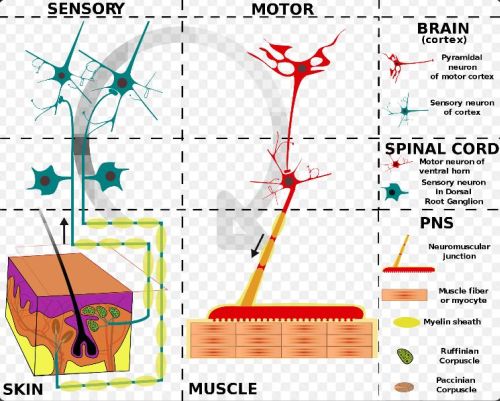
These 31 pairs of spinal nerves contain dendrites of sensory neurons and axons of motor neurons which conduct impulses necessary for sensations and voluntary movements. The skin surface area is supplied by single nerves called Dermatones.
The Sensory Neurons conduct impulses TO the Central Nervous System (Afferent) and the Motor Neurons conduct impulses AWAY from the Central Nervous System (Efferent), to the muscles and glands. Interneurons conduct impulses from the sensory neurons to the motor neurons and are central, connecting neurons.
The Interneuron is like the “Decision Maker” or “Associative” that decides whether or not you should move your hand, for example. To better understand nerve cells (or neurons), click here.
The Peripheral System:
So now, let’s move on to the Peripheral Nervous System. The Peripheral Nervous System consists of two parts called the Somatic Nervous System and the Autonomic Nervous System. It also consists of nerves and ganglia, both sensory (afferent) and motor (efferent.)
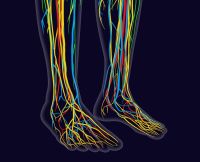
Remember that afferent nerve cells transmit information from the environment to the CNS, and efferent nerve cells do the opposite – they transmit information from the CNS to the outer extremities (arms and legs.) There are three groups of ganglia:
- Dorsal Root – spinal sensory (afferent)
- Cranial Nerve – contains cell bodies of cranial nerve neurons
- Autonomic Ganglia – cell bodies of autonomic nerves.
Remember that Ganglion refers to the Peripheral Nervous System. So now, let’s talk about the differences between the Somatic Nervous System and the Autonomic Nervous System.
The Somatic Nervous System:
The Somatic Nervous System contains cranial nerves (part of the Peripheral Nervous System), with the exception of the cranial nerve II. The Somatic Nervous System is responsible for what we think about doing, but also for the Reflex Loop (or Arc). The Reflex Arc is when the spinal cord makes a decision for us (such as when we jerk our hand away from a hot stove.)
The main function of the Somatic Nervous System is to control voluntary motion. The Neurotransmitter most prominent in the Somatic Nervous System is called Acetylcholine (Ach.) As mentioned above, there are two divisions of the Somatic Nervous System which include the Motor (Efferent) Neurons and the Sensory (Afferent) Neurons.
The Somatic Nervous System is responsible for integrating and controlling the skeletal muscles and is responsible for voluntary movement. Although the Brain initiates the signal, it is the Somatic Nervous System that carries out the message to extend the arm.
Remember that the Motor Neurons accept the signal FROM the CNS (brain and spinal cord) and sends that message to the target, skeletal muscle or organ. This originates in the spinal cord. These types of transmissions always begin in the spinal cord and create the signal in the form of an action potential. The signal then travels and ends up at the axon terminal.
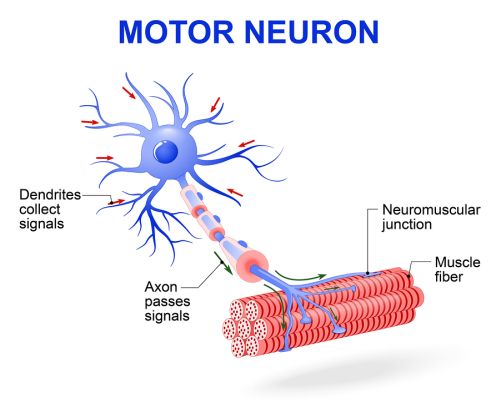
The Neurotransmitter for the Motor Neuron is Acetylcholine, which releases synaptic vesicles and ends up at the effector target. The Sensory Neurons (on the other hand), connect to receptors that pick up stimuli FROM the target muscle or organ and send that signal to the back side (dorsal side) of the spinal cord.
With the Motor Neuron, the cell body is inside of the spinal cord and with the Sensory Neuron, the cell body is found close to the back side. As mentioned above, the Somatic Nervous System also controls the reflex arcs that we are NOT in control of, which are quick and automatic. The best example of this is when we touch a hot surface.
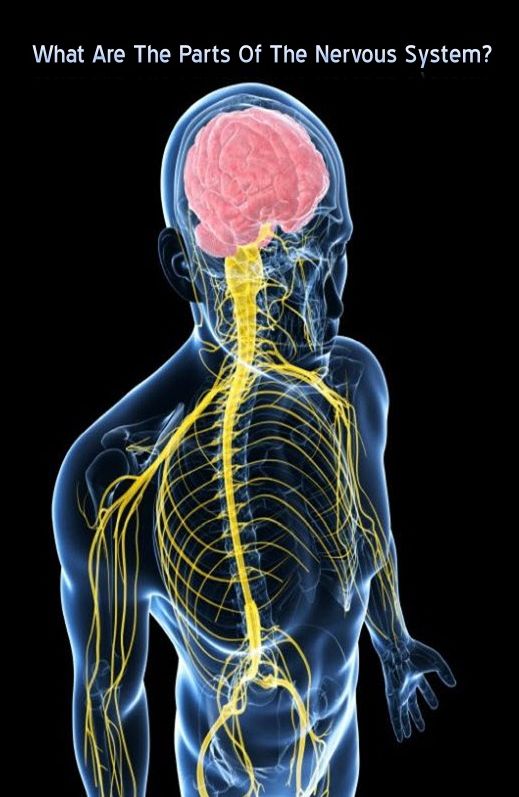
The Efferent Division of the Somatic Nervous System innervates (or connects to) the effector organs (or skeletal muscle.) This is done in a voluntary fashion. This includes the muscle fibers (or cells) and motor units (or motor neurons and fibers.)
The Neuromuscular Junction is where the motor neuron and muscle fiber meet. Here is where the Neurotransmitter Acetylcholine binds to the cholinergic receptors. There are two types of cholinergic receptors and they are Nicotine and Muscarinic.
What is the Autonomic Nervous System?
So, what is the Autonomic Nervous System? The Autonomic Nervous System is further broken down into two main parts called the Sympathetic Nervous System and the Parasympathetic Nervous System. The Autonomic Nervous System is most commonly referred to as the “Automatic” or “Involuntary” part of the Nervous System.
The Sympathetic Nervous System:
The Sympathetic Nervous System is best known for “Fight or Flight.” Again, sensory input travels from the environment to the CNS and this triggers motor signals back down (from the CNS) to the extremities. For 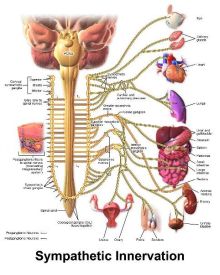 example, you may feel a bug crawling on your skin, integration takes place and you decide what to do, the motor output takes place and you jump up and down and run around!!
example, you may feel a bug crawling on your skin, integration takes place and you decide what to do, the motor output takes place and you jump up and down and run around!!
Your Sympathetic Nervous System picks up threats and alerts the rest of your body. This activates the Adrenal Medulla which releases Norepinephrine (adrenaline) into the bloodstream. This causes the Pituitary Gland to secrete the hormone ACTH, which arrives at the Adrenal Cortex and releases approximately 30 hormones.
Suddenly, the heart rate picks up, the breathing rate increases and the blood pressure rises. All sugar and fat are released to provide energy for muscles so that they are prepared for rapid movement (RUN!) In order for this to happen, digestion and urine production must be decreased. The Sympathetic Nervous System is your STRESS Response.
When in this Fight or Flight state, the pupils will dilate, deep breathing will take place, bowels slow down, blood pressure increases, major vessels dilate, muscles tense up, digestive enzymes are reduced, heart rate speeds up, blood vessels constrict, saliva decreases and chills and sweating take place. In other words, you are ready to respond instantly to a threat. The hormones of stress linger in your body for several hours or even days.
The Parasympathetic Nervous System:
The Parasympathetic Nervous System has the opposite effect. It is designed to calm you down. It is the “checks 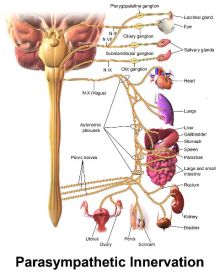 and balances” to keep you in check and make sure that you don’t get “overheated,” so to speak! This is also known as the “Relaxation Response” or the “Rest and Digest.”
and balances” to keep you in check and make sure that you don’t get “overheated,” so to speak! This is also known as the “Relaxation Response” or the “Rest and Digest.”
The Parasympathetic Nervous system has a calming effect. It helps your body to maintain homeostasis and minimizes your use of energy. This keeps your body system efficient. It counterbalances the Sympathetic Nervous System.
The Neurotransmitter most used in the Parasympathetic Nervous System is Acetylcholine (Ach.) This automatic response helps you to regulate all of your internal organs such as the heart, digestion, etc. The nerves for the Parasympathetic System originate in the neck and lower back areas, whereas, the nerves for the Sympathetic System originate in the middle of your back.
The Stress Response:
The Stress Response of the Sympathetic Nervous System can save your life when under immediate threat. The problem comes in when we are under chronic stress, even if we are not under immediate danger or threat. The chronic stress response can lead to illness and disease, and this is one of the main topics of this website. We want to prevent this if possible!

Hopefully, you found this article educational in helping you to understand what is going on inside of your body when you are under stress, and why an understanding of this is helpful for managing stress and therefore leading us to happier, healthier and more productive lives.
Does the nervous system inspire you? If so, how? Please feel free to comment below. All comments are very much appreciated!

